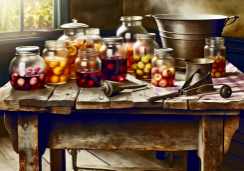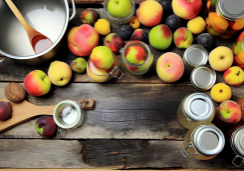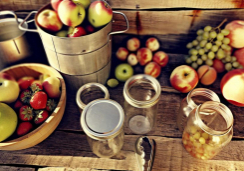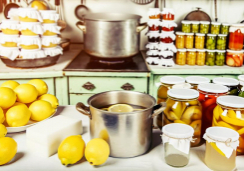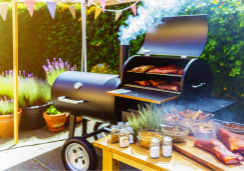4 Trusted Techniques for Home-Smoked Meats
Just as you're pondering how to elevate your backyard barbecue, it's no coincidence that the art of home-smoked meats has caught your attention. You're in for a savory journey, where mastering the smoke can transform even the simplest cut into a mouthwatering feast.
To ensure your success, you'll need to acquaint yourself with the four trusted techniques that can make or break the smoking process.
Choosing the right smoker sets the stage, while selecting quality wood chips or chunks infuses the desired flavor profile.
Temperature control is crucial; not too hot to prevent drying out the meat, and not too cold to ensure food safety.
Finally, the magic lies in your marinades and rubs—these concoctions will dictate the very essence of your finished product.
Stick around, as we're about to unveil the secrets that will turn you into the pitmaster of your neighborhood.
Choose the Right Smoker
Selecting the ideal smoker for your culinary adventures hinges on evaluating the pros and cons of each type, ensuring you pick a model that perfectly matches your expertise and smoking style. As a member of the Grill Masters Club, you know the importance of maintaining the ideal temperature for smoking. Whether you're drawn to the traditional smoke flavor of a charcoal grill or the convenience of an electric unit, each smoker has its unique benefits.
For the purist, nothing beats the authenticity of wood chips smoldering in a charcoal grill. You control the fire, the smoke, and ultimately, the flavor. However, mastering the indirect heat technique requires practice and patience. Wood chunks might offer a longer burn, but they also demand vigilance to keep that ideal temperature steady.
On the flip side, electric smokers offer a 'set it and forget it' approach, suitable for those who value convenience. Although you might sacrifice some smokiness, the precise temperature control is unbeatable.
Your grill or smoker becomes a reflection of your smoking process philosophy. The type of wood you choose—hickory, mesquite, apple—each imparts a distinct personality to your meats. Remember, the right smoker isn't just about capacity or looks—it's about complementing your lifestyle and elevating your grill game.
Select Quality Wood
Having chosen your ideal smoker, it's now essential to focus on sourcing quality wood, as it's the key to infusing your meats with rich, distinctive flavors. Smoking isn't just a cooking method; it's an art form that hinges on the subtle interplay between smoke and meat. The type of wood you use can dramatically alter the taste of your meats, adding layers of smoky flavor that complement the natural savoriness of the cut.
When selecting wood, opt for chunks rather than wood pellets to achieve a hotter and more flavorful burn. Each wood variety imparts a unique essence—hickory provides a strong, traditional smoke, while mesquite offers an intense earthiness. Fruitwoods like apple and cherry lend a milder, sweeter touch that's perfect for poultry or pork.
To truly master the craft, experiment with different woods and types of meat. Use indirect heat to envelope your meats in a gentle smoke, allowing the wood's essence to marry with the meat's juices, creating an unforgettable flavor profile. Remember, the goal is to add flavor, not overwhelm, so select your wood with care and always aim for balance.
Embrace the process, and your smoked meats won't just be food, but a testament to the alchemy of smoke and skill.
Master Temperature Control
To unlock the full potential of your smoked meats, you'll need to master the art of temperature control. This involves maintaining a sweet spot between 215 to 250°F for that perfect slow-cooked tenderness and flavor. When smoking meat at home, it's not just about setting the heat and forgetting it. You've got to keep an eye on it, adjusting the smokers vents to manipulate the temperature and maintain those low temperatures that are crucial for the art of smoking.
A meat thermometer isn't just a tool; it's your best friend in ensuring that your meat achieves the desired internal temperature without going overboard. Remember, smoking is a marathon, not a sprint. The key to succulent, fall-off-the-bone meat lies in your ability to control the temperature throughout the cooking process.
Adding a water pan can help stabilize the heat and add moisture, but you've got to be diligent. Adjust your vents, watch the thermometer, and don't let the temperature waver. Your patience will be rewarded with flavors that burst and textures that melt.
Mastering temperature control is an art that separates the novices from the experts in the world of home-smoked meats.
Flavor With Marinades and Rubs
Infuse your smoked meats with the essence of flavor by marinating or applying a carefully crafted rub before the smoking process begins. Marinades tenderize and impart a deep, succulent taste, while rubs create a savory crust that seals in juiciness. Both methods add layers of complexity to your culinary creations.
- Marinades:
- Immerse your meats in flavor-enhanced liquids to ensure tenderness.
- Experiment with ingredients like citrus, herbs, and spices to create delicious profiles.
- Allow ample time for the marinade to work its magic, ideally overnight.
- Rubs:
- Apply a dry rub generously to form a rich layer of flavor on the meat's surface.
- Customize your mix, perhaps using Sweet Orange Habanero Seasoning for a zesty kick.
- For optimal results, let the rub meld with the meat for several hours before smoking.
- During Smoking:
- Baste with barbecue sauce to add moisture and enhance flavors in your smoked dishes.
- Don't be afraid to mix marinades and dry rubs for a unique taste experience.
- Keep experimenting to find your signature style that friends and family will crave.
Frequently Asked Questions
What Are the Best Techniques for Smoking Meat?
You'll master smoking meat by perfecting wood selection, temperature control, and ensuring consistent smoke flow. Use indirect heat, trim meats skillfully, apply dry rubs, understand brining, aim for smoke rings, manage vents, and marinate effectively.
How Do You Prevent Creosote When Smoking Meat?
To prevent creosote, you'll need seasoned wood, precise temperature control, and proper ventilation. Ensure clean smoke flow, manage the fire carefully, and inspect your chimney regularly to avoid oversmoking and creosote causes.
What Do You Soak Meat in Before Smoking?
You'll soak your meat in a brine with the perfect balance of salt, sugar, and aromatic herbs, or a marinade blending acidic additives and oils for optimal flavor infusion and smoke adherence.
How Do You Keep Meat From Drying Out When Smoking?
To keep meat from drying out while smoking, you'll need to master maintaining moisture through temperature control, wood selection, and smoke density. Proper meat wrapping, brining basics, and basting methods are also crucial.
Conclusion
You've got the knowledge, now seize the flavor! Choose a smoker that feels like a trusty sidekick, pick wood that'll whisper secrets of smoke to your meats.
Keep that temperature steady—patience is your virtue here. And don't skimp on the marinades and rubs; they're the soul-song of succulence.
Smoke on, culinary warrior, and transform the ordinary into the extraordinary. Your taste buds deserve nothing less than the masterpieces you're about to create.




